*This post may contain affiliate links. Read more »
Khao Suey (also called Khow Suey) is a Burmese version of a classic Thai dish called Khao Soi. You can cook it on a stovetop, or in an instant pot. I have even whipped up some in our camper van in a cast iron dutch oven I like to travel with.
My vision of Khao Suey is a pot bubbling and simmering, a cauldron of dreams. Its contents, a rich and velvety coconut curry, swirled with decadence, transforming simple vegetables into a magical creation. The curry is totally different in flavor than Thai or Indian curries. It beckons with its vibrant hues, an invitation to turn any mundane veggie you add to it into a sponge for glorious golden coconut milk broth.


Enter your email & I'll send it to your inbox. Plus, get great new recipes from me every week!
By submitting this form, you consent to receive emails from Cinnamon Snail.
Bowls, like colorful canvases, stand at the ready, eager to be filled with the symphony of flavors. Tender, velvety noodles cooked directly in the curry bursting with flavor.
Garnishes adorn the table, like scattered jewels, inviting guests to partake in their own creation. Vibrant bean sprouts, crunchy fried onions, lime wedges, and fiery chili oil stood ready to harmonize with the creamy symphony. Sides like crispy rice dumplings, and crispy onion fritters, along with steamed compressed rice cakes accompany the curried noodles like old friends.
Get your favey pot or instant pot, tie up your cutest apron, because these noodles are full of flavor and are easy to modify for your dream bowl!
Jump to:
🥰Why you'll adore this khow suey recipe
🍠More versatile than a stir fry. Word is bond, son: With its versatile nature, Khao Suey is a fantastic base that welcomes a wide array of proteins and vegetables. Your favorite veggies or seitan can be great here.
🥦Vegan AF: Food fit for human consumption should never contain animals or animal products! ✊By opting for a fully or at least a partially plant-based diet, you're making a positive impact on your well-being, the well-being of animals, and the environment.
✅This recipe passes the test all over the world! Like all of the vegan recipes I share, this recipe has undergone rigorous testing to ensure its foolproof. Not only have I personally tweaked it to perfection, but it has also been tested by a group of hundreds of recipe testers from all around the world. You can have complete confidence in its meticulous development, guaranteeing an outstanding outcome EVERY. SINGLE. TIME.


💣 The BOMB vegan dinners that you need in your rotation
This guide to my most popular dinner recipes is 100% FREE, & you'll love the actual heck out of it 🥰
🌶️ Ingredients for khow suey
Unlike dishes like Pad Woon Sen that could require a trip to an Asian market, this curry uses regular ol' angel-hair pasta, which you might already have on hand.

Dried Chilies
Known as "Nga Yant" in Burmese cuisine, in addition to adding heat, are a rich source of capsaicin, which can boost metabolism and aid in digestion. I prefer the Byadagi chilies from Karnataka in India, and other dried chilies, such as arbol chilies, or dried red Kashmiri chilies work great too.
Chickpea flour
Also called “Besan" or “Gram flour”, is high in protein and fiber, providing sustained energy and promoting digestive health. It's the main ingredient in crispy onion bhaji. If unavailable, you can replace it with rice flour.
Jaggery
Known as "Htanyet" in Burmese, is a natural sweetener rich in iron and other minerals, providing a healthier alternative to refined sugar. If jaggery is not available, you can use brown sugar or coconut sugar as substitutes.
Pumpkin
Pumpkin or Kabocha Squash, is packed with vitamins A, C, and E, as well as fiber, promoting healthy skin and boosting immunity. If these varieties are unavailable, butternut squash or sweet potatoes are excellent alternatives.
Turmeric
Dried ground turmeric, known as "Nyein Chan" in Burmese, contains curcumin, a potent anti-inflammatory compound with antioxidant properties. It adds vibrant color to dishes while offering potential health benefits. If unavailable, you can substitute with either freshly grated turmeric or a generous pinch of safari threads.
*See the recipe card at the bottom of the page for exact quantities, nutritional info, and detailed cooking directions.
📖 How to make khow suey
I will walk you through the scary curry wilderness to Khow Suey triumph at the top of noodle mountain! Or you can follow along with the easy-to-print recipe card for this veg Burmese masterpiece towards the bottom of this page.
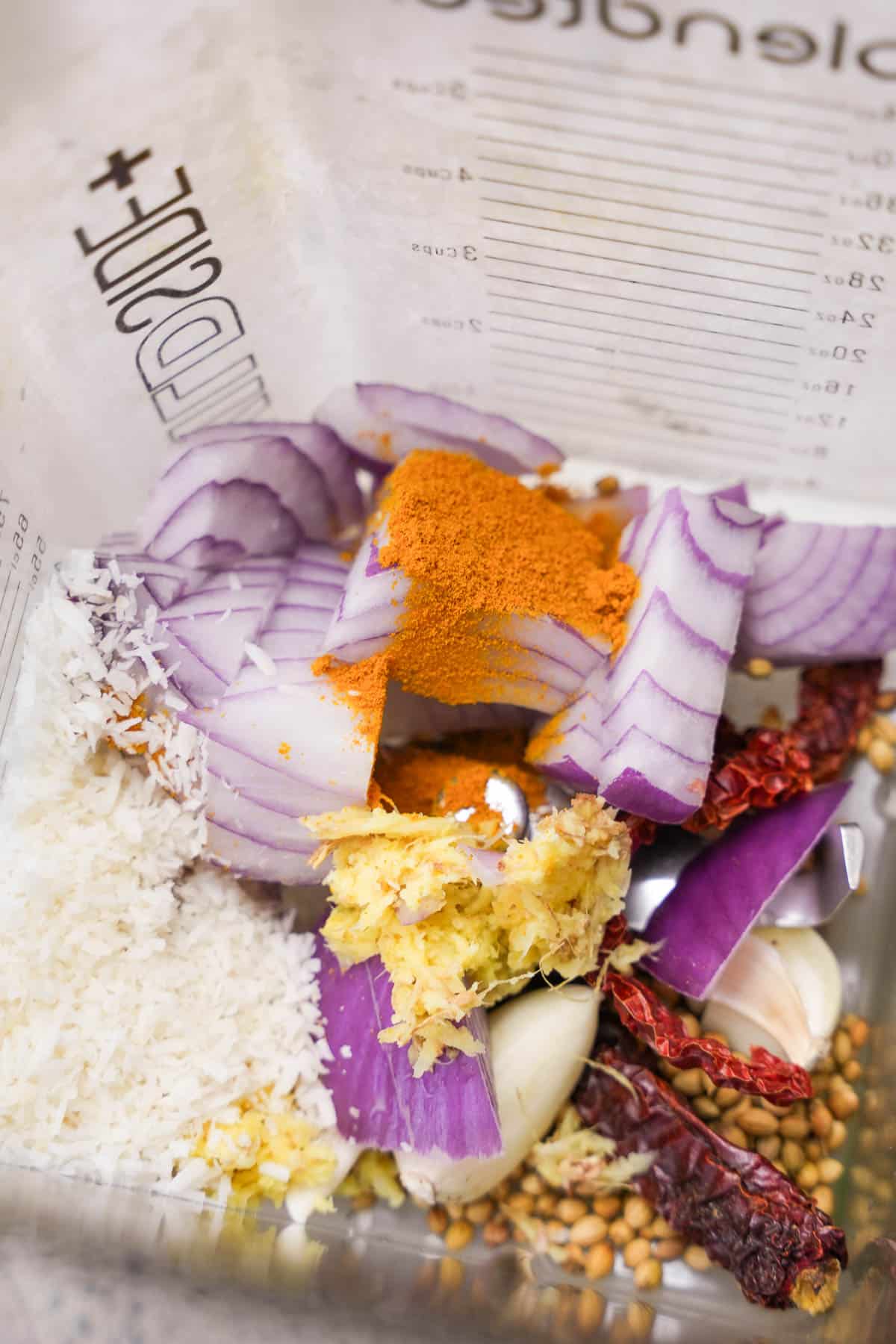
Step 1
Toast the dried red chilies and coriander seeds in a dry pan over medium heat until they become fragrant, usually taking about 2-3 minutes. This process enhances their flavors.
Once toasted, transfer the chilies and coriander seeds to a blender or mortar and pestle. Add garlic cloves, grated ginger, peppercorns (or ground black pepper), diced red onion, turmeric, shredded unsweetened coconut, and water.

Step 2
Blend or grind the ingredients until you achieve a smooth paste. Set it aside.

Step 3
In a large pot, heat canola oil over medium heat. When the oil is hot, add the curry paste and cook it for 2-3 minutes until it becomes fragrant. Stir frequently to prevent burning.

Step 4
Pour the canned coconut milk into the pot. 👉Make sure to use full-fat canned coconut milk for the richest curry.

Step 5
Mix water (or vegetable broth) with chickpea flour until the flour is fully dissolved. Add this mixture to the pot to help thicken the curry.
Add jaggery or brown sugar, diced pumpkin (or squash), and shredded carrot to the pot. Stir to combine. Adjust the sweetness by adding more or less jaggery or brown sugar according to your taste preference.
Simmer the curry on medium heat for 10-15 minutes or until the vegetables become tender, stirring occasionally. If the curry becomes too thick, add a little more water or coconut milk to achieve your desired consistency.

Step 6
When the vegetables are tender, break angel hair pasta into shorter lengths and add it directly into the curry. Add extra water as needed to prevent the pasta from absorbing all the curry sauce.
Stir in bean sprouts and salt to the curry. Ensure the pasta is well-coated with the curry. Cook for an additional 2-3 minutes to soften the bean sprouts.
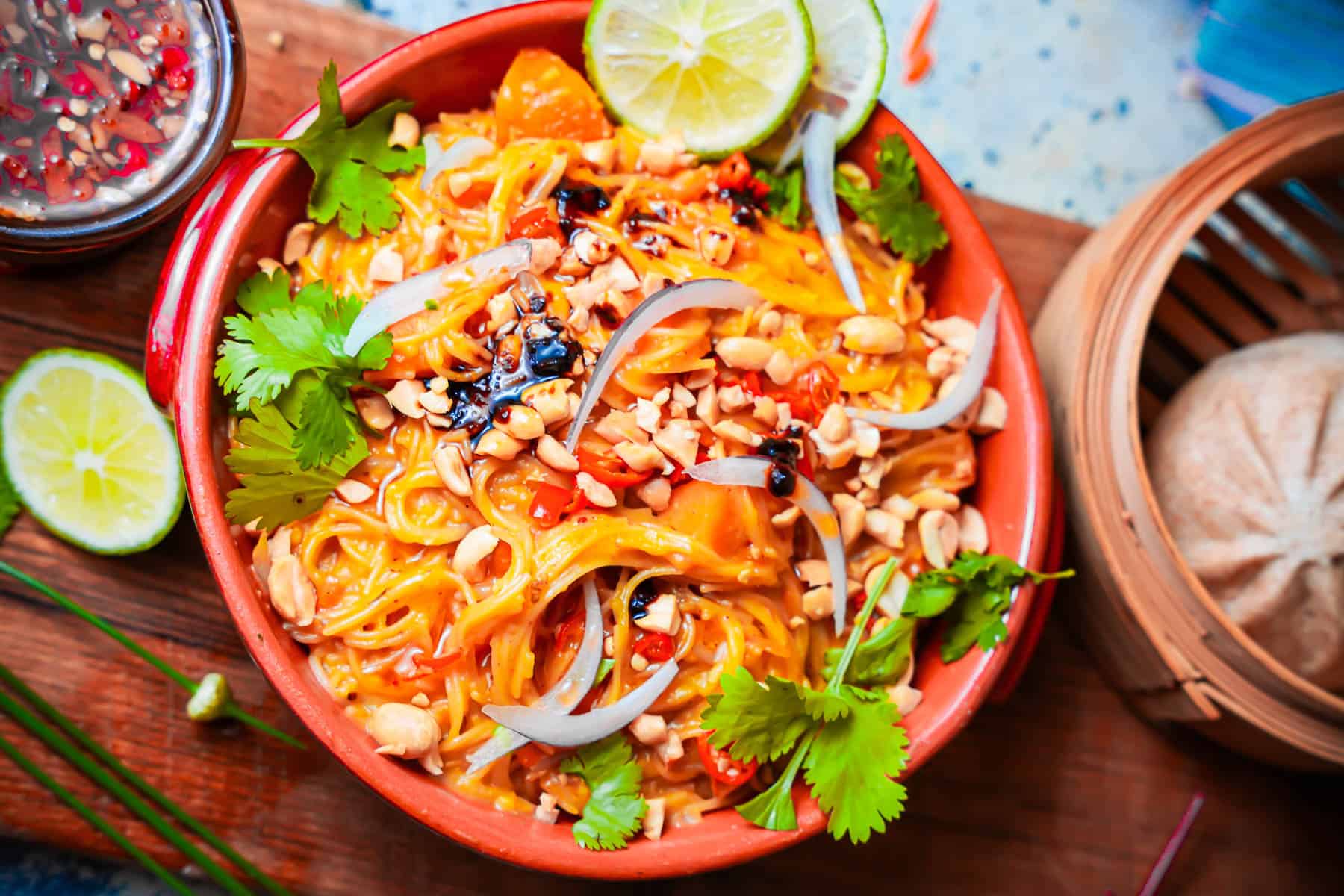
Step 7
Portion the Khao Suey into serving bowls. Garnish each bowl with thinly sliced red onion or shallots, sliced bird's eye chili, a drizzle of chili oil (optional), crispy fried onions (optional), chopped cilantro, chopped roasted peanuts, cilantro leaves, and a squeeze of lime juice. Alternatively, you can place the garnishes in bowls on the table, allowing each person to garnish their own portion according to their preference.
🍽️Serving Ideas
Because Myanmar is at the crossroads of so many Southeast Asia countries with diverse culinary styles, this Khow Suey recipe beautifully accompanies everything from Thai, to Vietnamese, Indian and even Chinese dishes!
Here are some dishes from different countries that complement Khao Suey nicely:
Indonesian Cuisine:
- Lontong: Compressed jasmine rice cake cooked in banana leaves.
- Sayur Lodeh: Mixed vegetable stew cooked in a fragrant coconut milk broth.
- Ketoprak: A traditional Indonesian salad with tofu, rice vermicelli, and vegetables, topped with peanut sauce.
Chinese Cuisine:
- Chee Cheong Fun: Steamed rice noodle rolls served with a variety of sauces.
- Crispy Rice Dumplings: Deep-fried dumplings made from sticky rice and filled with savory ingredients.
Japanese Cuisine:
- Tofu Katsu or nasu denkagu with a side salad with Goma dressing and Yamagobo: Breaded and fried tofu cutlets served with a refreshing salad dressed in sesame dressing and pickled burdock root.
Korean Cuisine:
- Vegan Bulgogi: Marinated and grilled plant-based protein
- Kimchi Fried Rice: Fried rice cooked with spicy and tangy homemade kimchi. Great for topping with grilled tofu or eggplant cooked in my killer Korean bbq sauce.
Indian Cuisine:
- Medhu Vadai: Fried lentil fritters, crispy on the outside and soft on the inside.
- Arhar Dal Tadka: A flavorful lentil soup tempered with spices,
- Aviyal: A mixed vegetable curry in a coconut-based sauce, with a tangy and mildly spicy flavor.
- Shakarkandi Ki Chaat: A sweet and savory street food snack made from roasted sweet potatoes, spices, and fried chickpeas noodles.
- Masoor Dal: Red lentils cooked with aromatic spices and served with rice or bread.
- Vegan Butter Chicken: a KILLER seitan-based version of the classic butter chicken dish, which is baller served with fragrant vegetable biryani or coconut and pandan-infused rice.
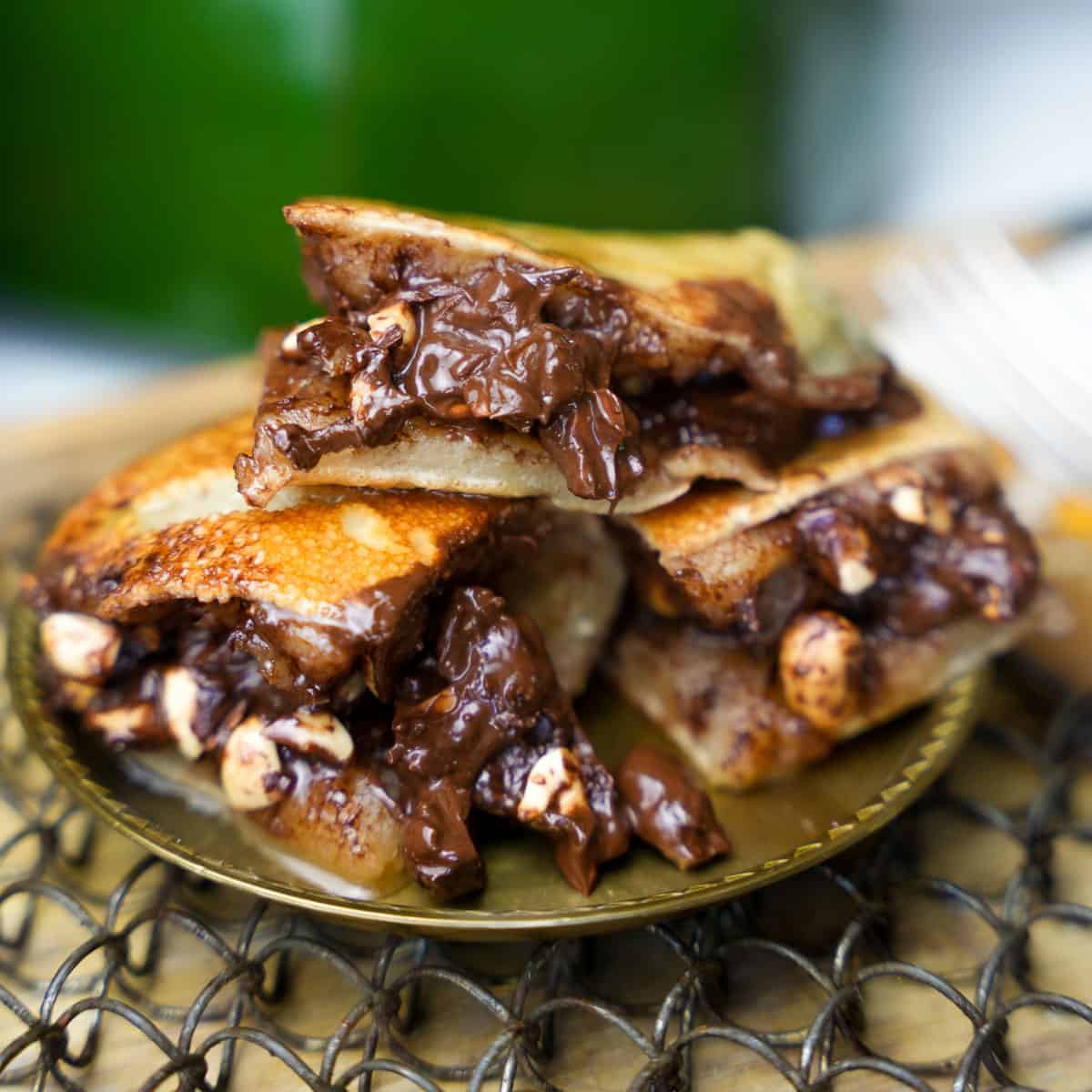
🤷♀️FAQ
Traditionally, both the Burmese dish Khao Suey and the Thai dish Khao Soi that it has evolved from do not contain dairy in their preparations. The base of the dish is usually made with a combination of coconut milk, curry paste, and various spices to create a rich and flavorful curry.
However, variations of Khao Suey exist, and some recipes or regional adaptations might include dairy products as an ingredient. This is especially a concern in countries where coconut milk is not easily available, or where dairy is significantly cheaper to use.
Because the angel hair pasta used in this recipe, and most typical Khao Suey soup is made from wheat, it's not gluten-free by default. However, you can easily substitute rice noodles, or bean thread noodles if you have a gluten sensitivity.
❄️See ya later ‘frigerator
Once cooked, allow the Khao Suey to cool down to room temperature.
Transfer the leftover Khao Suey to an airtight container.
Store it in the refrigerator for up to 3-4 days. It is important to store the curry and noodles separately, if possible, to maintain their texture.
🔥Stovetop reheating
Transfer the desired portion of Khao Suey to a pot.
Add a splash of water or vegetable stock to the pot to prevent the curry from drying out.
Heat the pot over medium-low heat, stirring occasionally, until the Khao Suey is heated through. This usually takes 5-7 minutes.
☢️Microwave reheating
Place the desired portion of Khao Suey in a microwave-safe dish.
If the curry and noodles were stored separately, mix them together in the dish.
Cover the dish with a microwave-safe lid or microwave-safe plastic wrap to prevent splatters.
Microwave on medium power for 2-3 minutes, or until the Khao Suey is thoroughly heated. Microwaves can vary, so adjust the time accordingly.
I recommend storing the garnishes separately or preparing them fresh when serving the reheated Khao Suey. The garnishes, such as thinly sliced red onion, sliced bird's eye chili, cilantro, and lime juice, should be added to the reheated Khao Suey just before serving to provide the best contrast in texture, temperature and freshness.
The origins of Khao Suey can be traced back to Thailand, where it is known as "Khao Soi." The dish is believed to have originated in Northern Thailand, specifically in the city of Chiang Mai, which shares a border with Myanmar. My wife and daughters spent a winter there volunteering at an elephant sanctuary and fell in love with the cuisine of Chiang Mai.
Khao Suey underwent a fascinating evolution, adapting to local tastes and ingredients as it made its way across the border into Burma (the country which is now called Myanmar. The name change from Burma to Myanmar resulted from a political decision made by the military junta in 1989, seeking to emphasize the country's historical and cultural diversity by adopting a name that better represents its various ethnic groups).
The Burmese version of Khao Suey typically features a rich and creamy coconut milk-based broth infused with an array of spices such as turmeric, coriander, and ginger. The broth is often served with egg noodles and topped with various condiments, allowing for customization to individual preferences.
What sets the Burmese Khao Suey apart from its Thai counterpart is the inclusion of additional toppings and garnishes. These can vary but often include fried garlic, crispy onions, lime wedges, pickled vegetables, and sometimes additional protein like chicken or shrimp, or for those of us who love animals: tofu, "the other white meat".
✌️My favey dishes to serve with khow suey:
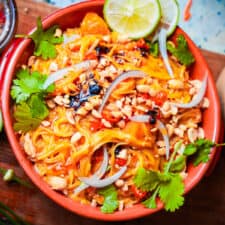
Burmese Khao Suey (Curried noodles from Myanmar) | Vegan Khow Suey
Equipment
Ingredients
Curry paste
- 3 dried red chilies Byadagi chilies or arbol chilies
- 1 tablespoon coriander seeds
- 3 garlic cloves
- 1 teaspoon grated fresh ginger
- 4 black peppercorns or ¼ teaspoon ground black pepper
- ½ cup diced red onion
- ¼ teaspoon turmeric powder
- 2 tablespoons shredded unsweetened coconut
- 2 tablespoons water
Curry ingredients
- 4 teaspoons canola oil vegetable oil, or sunflower oil
- 13.5 oz. 400 ml canned coconut milk (full-fat)
- 1.5 cups water/vegetable stock use up to 3 cups if you want a brothier curry
- 4 teaspoons chickpea flour aka gram flour or besan
- 1 tablespoon jaggery or brown sugar
- 1 cup diced pumpkin kabocha squash, or ash gourd
- 1 medium carrot julienne cut or shredded
- 8 oz. dried angel hair pasta broken into smaller pieces
- 1 cup bean sprouts
- ½ teaspoon salt
Garnishes
- Thinly sliced red onion or shallots
- 1 thinly sliced bird’s eye chili
- Chili oil optional
- Crispy fried onions optional
- ¼ cup cilantro roughly chopped
- ¼ cup chopped roasted peanuts
- Cilantro leaves
- 1 lime sliced
Instructions
- In a dry pan, roast the dried red chilies and coriander seeds over medium heat until fragrant, for about 2-3 minutes. Transfer the roasted chilies and coriander seeds to a blender or mortar and pestle. Add garlic cloves, grated ginger, peppercorns (or ground black pepper), diced red onion, turmeric, shredded unsweetened coconut, and water.
- In a blender or food processor, blend or grind until a smooth paste is formed. Set aside.
- Heat canola oil in a large pot over medium heat. Add the curry paste and cook for 2-3 minutes until fragrant, stirring frequently to prevent burning.
- Pour in the canned coconut milk.
- Mix the water (or vegetable broth) with the chickpea flour, until the flour is dissolved. Add it to the pot to help thicken the curry.
- Add jaggery or brown sugar, diced pumpkin (or squash), and shredded carrot. Stir to combine.
- Simmer the curry on medium heat for 10-15 minutes or until the vegetables are tender, stirring occasionally.
- When the vegetables are tender, break up the angel hair pasta into shorter lengths, and cook it directly in the curry. Add extra water as needed so that the pasta doesn’t absorb all of the curry sauce.
- Add the bean sprouts, and salt to the curry. Stir to combine, making sure the pasta is well-coated with the curry. Cook for an additional 2-3 minutes to allow for the bean sprouts to soften.
- Portion the Khao Suey into serving bowls.
- Garnish each bowl with thinly sliced red onion or shallots, sliced bird's eye chili, a drizzle of chili oil (optional), crispy fried onions (optional), chopped cilantro, chopped roasted peanuts, cilantro leaves, and a squeeze of lime juice. Alternatively, you can place the garnishes in bowls on the table, allowing each person to garnish their own portion as desired.
Notes
- Consistency Matters: Pay attention to the consistency of the curry and sauces. If they're too thick, you can add more liquid; if too thin, let them simmer longer.
- Don't Rush Simmering: When simmering the curry or sauces, give them the suggested time to develop flavors fully. Rushing this step might result in a less flavorful dish.
- Angel Hair Pasta Timing: Be mindful of the cooking time for the angel hair pasta. It should be al dente before you add it to the curry, as it will continue to cook in the sauce.
- Garnish Creatively: The garnishes are not just for looks; they add layers of flavor and texture. Don't skip them, and feel free to customize based on your preferences.

Enter your email & I'll send it to your inbox. Plus, get great new recipes from me every week!
By submitting this form, you consent to receive emails from Cinnamon Snail.

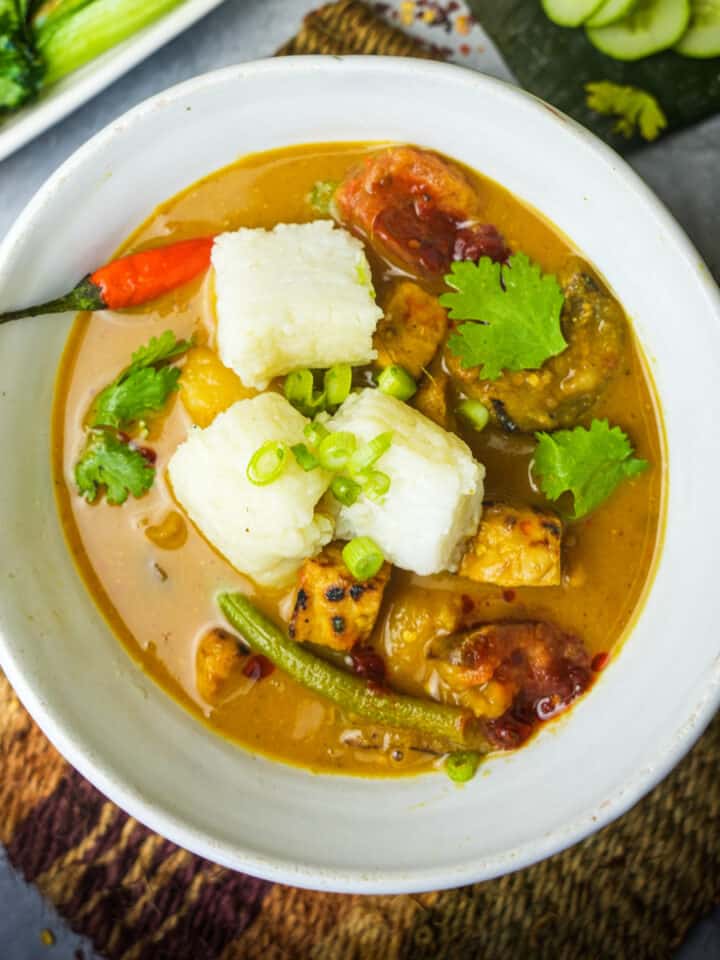
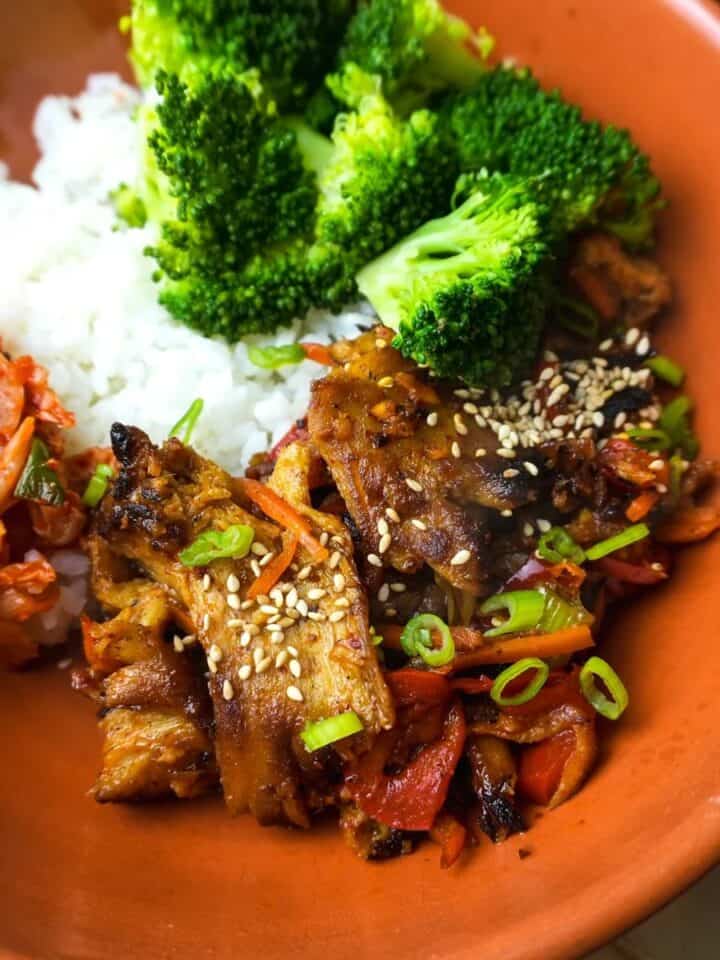
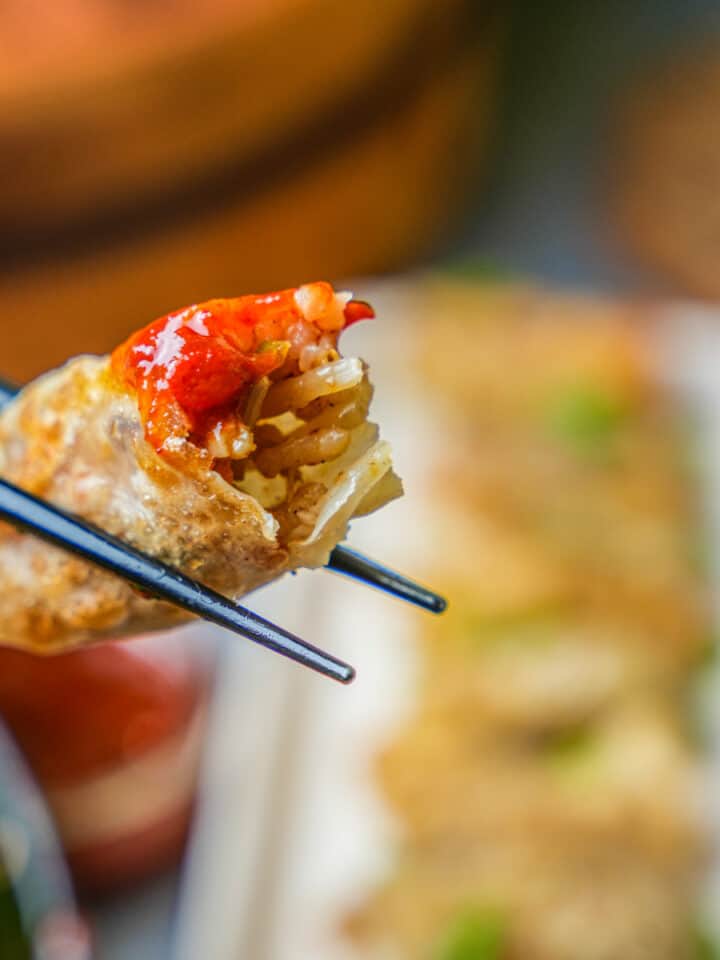
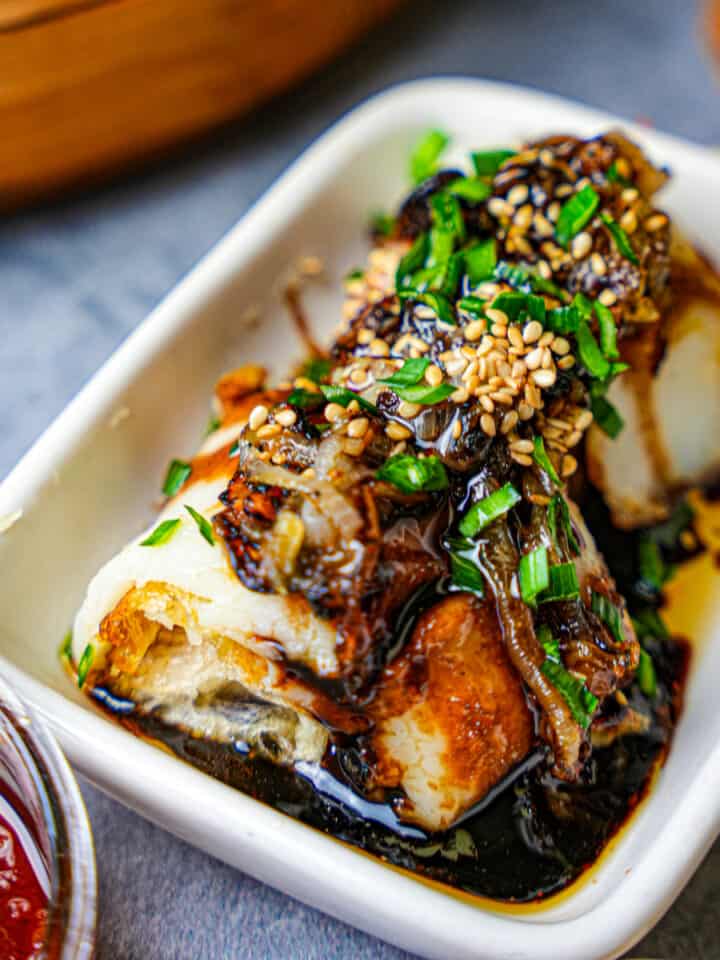
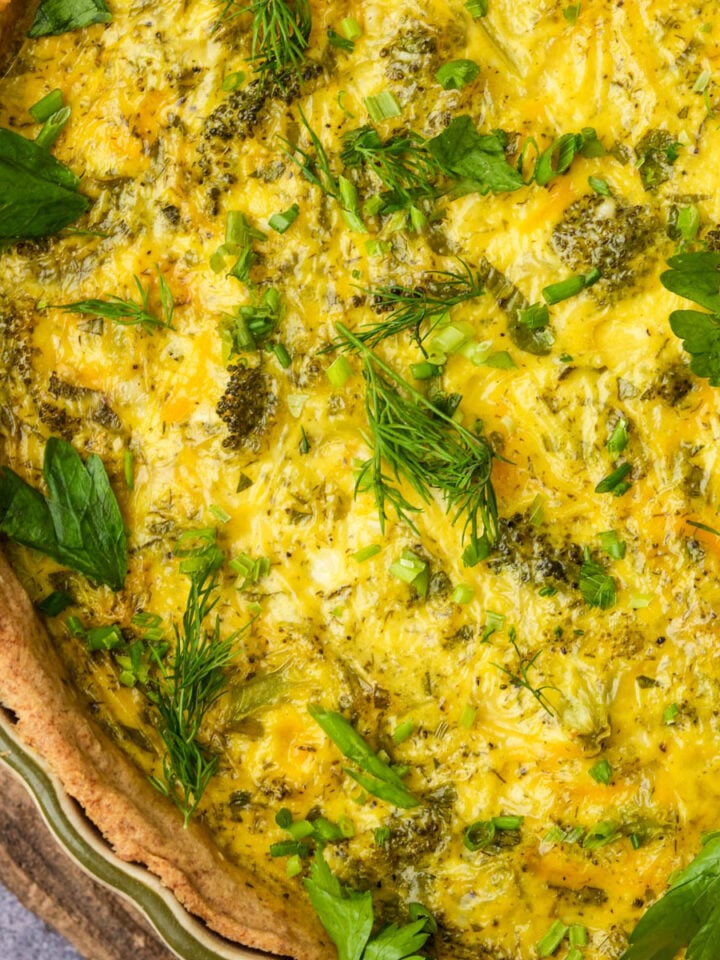



Leave a Reply